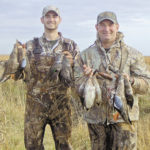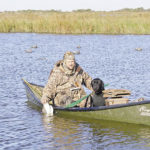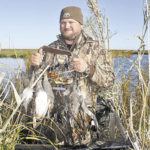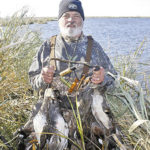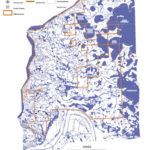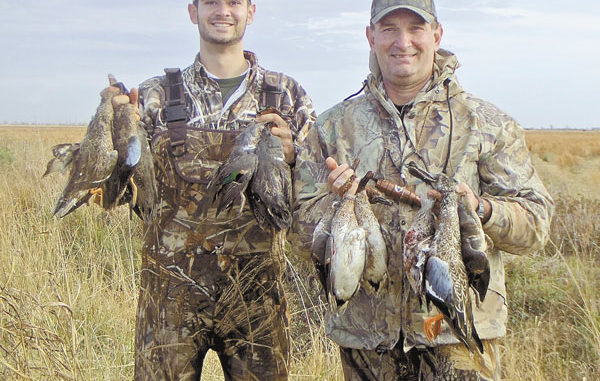
This public hunting area is full of ducks, and there’s no real reason to get up early to get there.
Amazing!” Eddie yelled while watching his cork dance in the current around a finger of marsh jutting into Muscle Bay. “Pelayo’s Point — and it’s still here! Like the hurricane never happened.”
“Oh, it happened alright,” quipped Pelayo, who inspired the point’s title after landing three gorgeous flounder on three casts while tottering on platform shoes below billowing bell-bottoms.
Straight from a festive Fat City and without changing clothes, we’d hitched up the boat on that Saturday morning, and thrown in the rods. No pelicans flapping around back then, but as we blazed down Bayou La Loutre, the flapping from our polyester collars perfectly presaged their future wingflaps.
“Just ask Artie what happened to his folks’ camp on Grand Isle,” Pelayo continued. “It’s almost totaled. We’ll all be going down there next week to help with repairs. Coming? Seems like the least we could do, considering how we use and abuse that place.”
“And speaking of using and abusing,” Eddie turned around after popping his cork, his eyebrows dancing. “Ran into Priscilla last week. Thought for sure she’d be hiding out after her latest ride on the mechanical bull…”
“Whoooo-boy!” Pelayo whistled from the bow after unhooking a school speck. “I like the way Zachary’s (in Tiger Plaza) now advertises her name on the marquee every Friday, ‘The Queen of the Mechanical Bull!’”
Priscilla would close her eyes. Her golden hair shimmered under the smoky lights. Her curvy body undulated in perfect concert to the bull’s motion. Compared to Priscilla’s performance, Debra Winger’s mechanical-bull routine in Urban Cowboy comes across like Janet Napolitano on an exercise bike.
The hurricane that had miraculously left the Biloxi Marsh intact in the above episode was in fact Hurricane Bob in July 1979, a year before our fishing trip that inspired Eddie’s observation. Fast forward three decades, and we found ourselves casting around Pelayo’s Point again — swatting and scratching at the bedeviling gnats but amazingly, with Eddie’s observation still apt.
“This Biloxi Marsh sure held up well to Katrina and Gustav!” Eddie remarked as he scratched his ears and nostrils.
The point was certainly shorter and thinner, but still hanging on. For the past couple years, Eddie’s been doing most of his duck hunting in Artie’s lease north of Lake Lery. The contrast between the hurricane ravages in that area and the resilience of the firm Biloxi Marsh was startling.
Equally startling were the ducks we kept putting up. A high tide gave us access through a network of skinny bayous into normally shallow ponds to stalk reds. Greys and teal kept erupting as we moved around. Not like in the glory years (mid- to late-’90s) mind you, but certainly more than we’d seen in this area the past few years. Amazingly, we’d even pulled up some widgeon grass attached to our beetles — nothing like the amount of widgeon grass, millfoil and coontail that engulf our beetles and cripple our spinnerbaits in the Delacroix area lately, mind you.
But-again-we were encountering more grass than we’d found in this area since Katrina. The seepage through the Bonnet Carre spillway and (perhaps?) the MRGO closing seem to have affected salinities in this area. And the ducks seem to have responded. (The fall drought in the Midwest didn’t hurt either, forcing many down to their traditional wintering grounds.)
Not that they blanket the area as in the Mississippi Delta at times and around Caernarvon today. But they seem to have returned, and can be found in pockets, as was always the case around here. Scouting was always a must in this Biloxi Marsh. The fishing, needless to say, makes this scouting almost as inviting as the hunting itself.
For us, however, some of this scouting takes place on the very morning of the hunt. Hence our late starts — to assure that ducks are using that area that very day. Ducks can be extremely nomadic in this vast brackish marsh. Sure, all ducks, regardless of habitat, respond to hunting pressure. On top of that, in the tidal marshes, we’ve got those fickle water levels that send ducks scooting away from, or swarming into, certain regions from week to week — heck, from day to day!
We simply follow them. Our duck hunting strategy is simple. Go to them. Then wait for them to come back to you. We ride until we find them, spook them in the process of setting up, then wait for them to return. Many (if not most) always do, but not immediately.
Dabbling ducks (pintail, greys, widgeon, teal, mallards) like it shallow, usually a foot or less of water. Here they can tip up to reach the seeds and grasses from the bottom. In the southeast marshes, a five-degree shift in the wind from north to just slightly northeast (or vice versa) can mean a 10-inch tidal change in two days. An area crammed with greys and teal during your scouting trip might have two mergansers and three dos gris when you come back. The high tides put the widgeon grass out of beak range.
Then another front barrels through, and the greys pour back in. It’s unreal. This on top of the regular daily tidal ranges. Nowadays, I find myself checking Louisiana Sportsman’s tide guides as fanatically for duck hunting as for fishing.
But food never seemed like the primary attraction for ducks in the Biloxi Marsh. Even in the “glory years,” grass beds in the Biloxi Marsh ponds were sparse and scattered, with widgeon grass (more a brackish-water product) predominating instead of milfoil, coontail and smartweeds (more fresh-water products).
Remoteness and seclusion always seemed more like the Biloxi Marsh’s attraction to ducks. It’s a nice little haul out here, especially to the Bayou Domingo/ Goose Flat areas we like to hunt. But it’s worth it to avoid crowds and the always attendant skybusting among the other delights of hunting “easy-access” places like Manchac and Big Branch. What a joke.
Point is, if luscious aquatic vegetation were the single issue, then the Manchac and Lake Salvador areas would be CRAMMED with puddle ducks. And we know they aren’t. Apparently ducks are attracted by more than a brimming salad bar.
And for whatever reason, our success in this Biloxi area — especially in the more salty to brackish outlying marsh — tends to come late-morning. Sometimes we attribute the late-morning flights to fishermen putting up ducks, which no doubt accounts for some of it. But there might be more to this phenomenon.
To wit: Legendary outdoor author Robert Ruark wrote about a duck hunt in lower Terrebonne Parish where he picked and ate oysters from his blind!
“Oysters?” I thought. “This was in 1951. Plenty fresh marsh back then. Why would he (a towering outdoor celebrity of the time, hunting with prominent locals no doubt) be hunting salt marsh?
Ruark went on to mention how by late in the morning, huge flocks of puddle ducks would wing south into the brackish-salt marsh to rest after feeding in the fresh marshes to the north and around Houma.
Well, the same thing seems to apply in other areas of our coast. We’ve often witnessed the Plaquemines and St. Bernard versions of what Ruark saw in Terrebonne. And for whatever reason (probably because of low tides from fronts plus hunting pressure close to the launches), we notice more ducks in the outlying marsh during late season.
Much like deer, ducks have their feeding and their resting (roosting) areas. Think about it. Rice field hunting is typically early morning, crack-of-dawn stuff, the ducks buzzing all around even before legal shooting hours. These rice fields are obviously feeding areas.
Up in the Midwest, duck hunters know that ducks feed in the crop fields early morning then fly into the reservoirs, lakes and flooded timber later on to rest. Here’s where they ambush them. A version of this same principle governs duck flight patterns in our coastal marshes.
“Hunting perverts the soul,” wrote Ruark. “No waterfowler is sane. He smokes an opium all his own.”
Here was perfect proof, as we weaved down Crooked Bayou bundled up against the icy wind and wedged amongst the three ‘rogues and two sacks of dekes on board. Yes, this “opium” that motivates us is nothing but a mental picture: a 3-pound bird turning to our beckon from a little plastic whistle, slowing his wingbeat, cupping his wings and slowly cascading toward some molded plastic shapes bobbing in the water before us. Perverse, indeed. Crazy, indeed. But for the afflicted, there is no cure.
Rounding a sharp bend with Pelayo’s outboard cavitating horrendously as we neared Bayou Domingo, some ragged groups of ducks started lifting around us. The greys launched straight up, and quickly broke up into smaller groups. Here and there, pairs of mottled ducks from the potholes. And a huge, nervous flock of teal buzzed erratically over the water until the others were specks in the crimson sky.
No duck clouds like we’d seen on “invite hunts” to Caernarvon and Welch earlier in the year. But this was a hunt in the most genuine sense of the term. So we were seriously, seriously pumped by the (late) morning’s prospects. The juices were flowing like on no invite-hunt, which we prefer to call “duck shoots” rather than “duck hunts.”
A good portion of those ducks would filter back in singles, pairs and small groups all morning. How often we spook ducks on the way out on fishing trips, then again a few hours later on the way in — and from the same ponds? They came back. Ducks pick certain ponds for a reason. One day we’ll discover that reason and end the mystery. But I hope not anytime soon, for the sake of Ruark’s description of us.
By the time we parked the boat and started unloading the pirogues it was almost 7:45 — when most duck hunters are returning to Delacroix area launches. The thickly-ponded western edge of the Biloxi Marsh near Lake Borgne gets what little pressure exists out here. And our experience is that the mid to eastern area gets flights later in the morning, either because these saltier ponds serve as resting areas or because of the pressure out west close to Lake Borgne. Or because of both.
I was throwing out the decoys with Eddie while Pelayo was on the bank fashioning an impromptu blind with the palmetto leaves and small bundle of fluffy bamboo we always bring along. We stick five palmettos in front, and five in back of the 14-foot pirogue which serves as the base of our portable blind. Then erect a thin screen of bamboo to blend better with the marsh. Maybe one day we’ll graduate to surface-drive boats. But tradition dies hard with these lunatics.
We set out the bulk of the 32 decoys in a cove to the right of the blind, not directly in front. Greys prefer to land in open water away from the bank. With the wind at an angle from our backs this would put any incoming ducks in front of us as they approached the decoys.
The ‘rogue bumped the bank and I saw Pelayo pointing and scurrying for cover. Indeed. Four greys were already returning. But we didn’t scurry fast enough, and they flared. But what a gorgeous sight and portent!
Just as Eddie dragged the pirogue behind the brush-blind, a pair came in unannounced and — spliiissshh. Another six were right behind, cupped up beautifully, the sun, well over the horizon by now, shining off their white bellies. They were so close we could hear the wind rushing through their wings as they descended. Yes! We were definitely entranced by that “opium.”
But again we screwed up. The ducks saw the movement, and heard the clicking and clacking as we frantically stuffed in the shells, and they flapped off. We huddled there as a stiff north breeze swished the bamboo around us. Here’s another advantage. This leafy stuff blows around, it looks natural — unlike that stiff, unnatural edifice that roseau creates.
Then Pelayo nudged me. “Teal!” he hissed while pointing with his chin as a flock of about eight ducks splashed into the spread not 15 yards in front of us.
“Pretty big teal,” I was thinking.
As we rose and shouldered the guns, there were greys flapping off in every direction. Usually when that many ducks land that close, they’re either teal or dos gris. Not here. Not when you’re set up in a remote area where they want to land.
A wild flurry of furiously flapping wings filled the sky — BLAM! A big-headed drake crumpled to Pelayo’s first shot. Blam! Another on my left as Eddie cut loose. “Shu-wuck” went his pump — BLAM! — and another one staggered on the perimeter of the decoys while a few feathers flew from his tail. BLAM! BLAM! Both Pelayo and I zeroed in on it for the kill shot.
BLAM! Still another folded after a 30-yard going-away shot from Eddie. He landed with a mighty splash and a puff of feathers. Amazingly, a slow one still lingered overhead. He was flapping hard against the wind for some reason and the angle of his flight put him right overhead. I swung and led him about a foot, hit the trigger — BLAM! — and kept swinging. He crumpled, missing us by 5 feet as he thumped on the cordgrass behind the ‘rogue.
We sat there wide-eyed, shaking with idiot grins. Then the whoops and high-fives started — until we spotted another flock banking in from the right, ducked and mouthed the calls for a few chuckles, for the mere principle of the thing. They were decoying regardless.
An absolutely glorious morning of duck HUNTING ensued. The high-fives and warm glow of rollicking success continued on the ride home. And we had barely bagged half the three-man limit, mostly teal and greys with a pair of spoonies and a redhead to pretty-up the strap.
